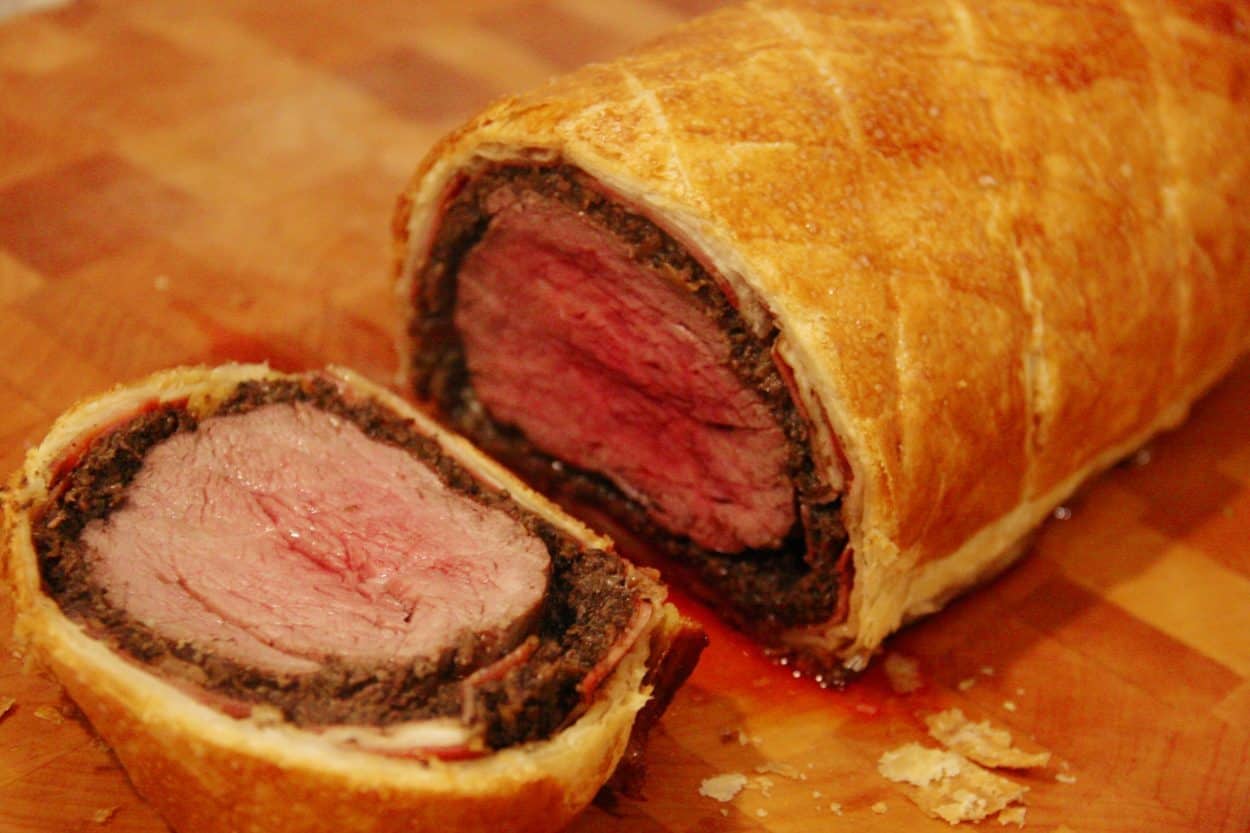
Tenderloin Series 1 Beef Wellington
How to Prepare a Whole Beef Tenderloin?
There is no more idolized cut than the beef tenderloin, and with good reason. They say the further you get from the hoof and the head the more tender the cut, that apex is where the tenderloin is located. This long muscle does very little work and so it develops a lighter flavor with a soft and delicate texture. This cut has so many versatile options that we couldn’t select just one, so we are bringing you a series on how to breakdown a whole beef tenderloin with three delicious recipes.
BUTCHERING A TENDERLOIN
Most commercial grocery stores will sell a whole tenderloin partially cleaned. You can ask your butcher to clean the muscle the rest of the way but where is the fun in that? Cleaning a beef tenderloin can be very simple if you know a few key principles.
- Cut as shallow as possible
- Remove all silver skin.
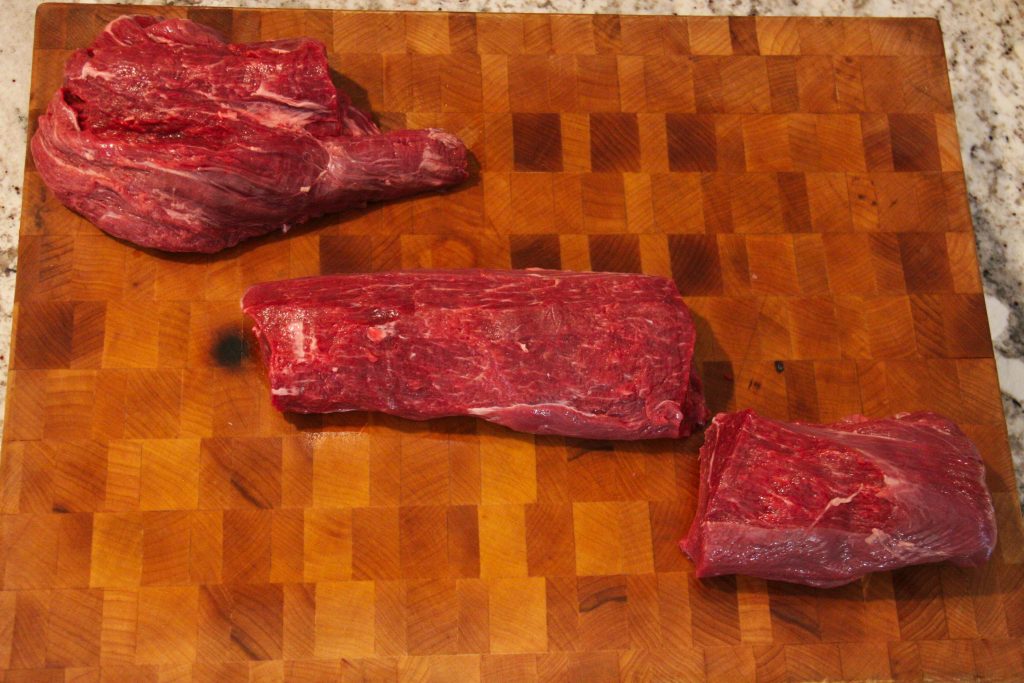
Start by placing your tenderloin on your cutting board with the head on your non dominant side. Place the tip of a sharp boning knife under a section of silver skin just below the surface. Tilt the knife blade so it is just above horizontal, while holding the silver skin tight, slide the knife along the silver skin till it ends. Turn back towards the head, while holding the silver skin strip tight, make the same movement all the way up to the top of the head. Repeat this procedure till you have removed all the silver skin.
Now, work your way around the head, looking for any silver skin to remove from where these two muscles come together. Remove any excess fat or silver skin from the backside of the tenderloin. And there you have it, a perfectly clean and ready to use tenderloin.
We want to break down the tenderloin into three parts: the head, the body, and the tail. Each of these will get their own recipe and today we are starting with the “King of Kings”, the Châteubriand or body of the tenderloin.
THE BEST BEEF WELLINGTON
While there may be mystery surrounding when and where this dish originated it saw a surge in popularity in the late 1950’s in America, it was Richard Nixon’s favorite meal. Thanks to shows like Downton Abbey and chef Gordon Ramsey this dish is iconic for being both delicious and elegant, but also complicated and difficult. We want to change that and help walk you step by step through the process and how, with the proper temperature tools, we can make the best beef wellington you have ever tasted.
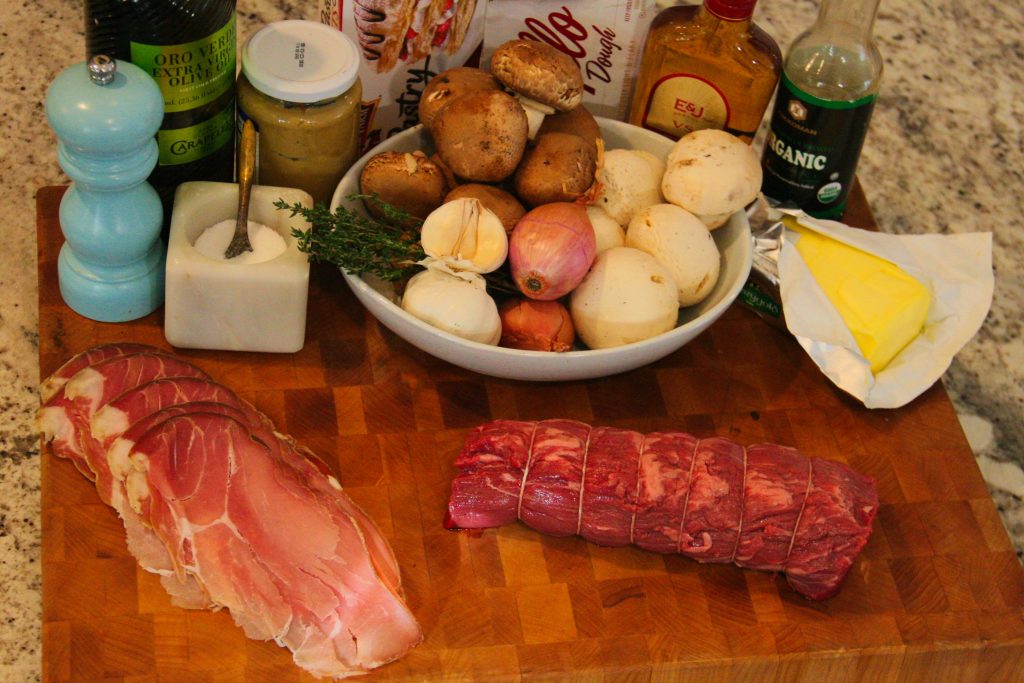
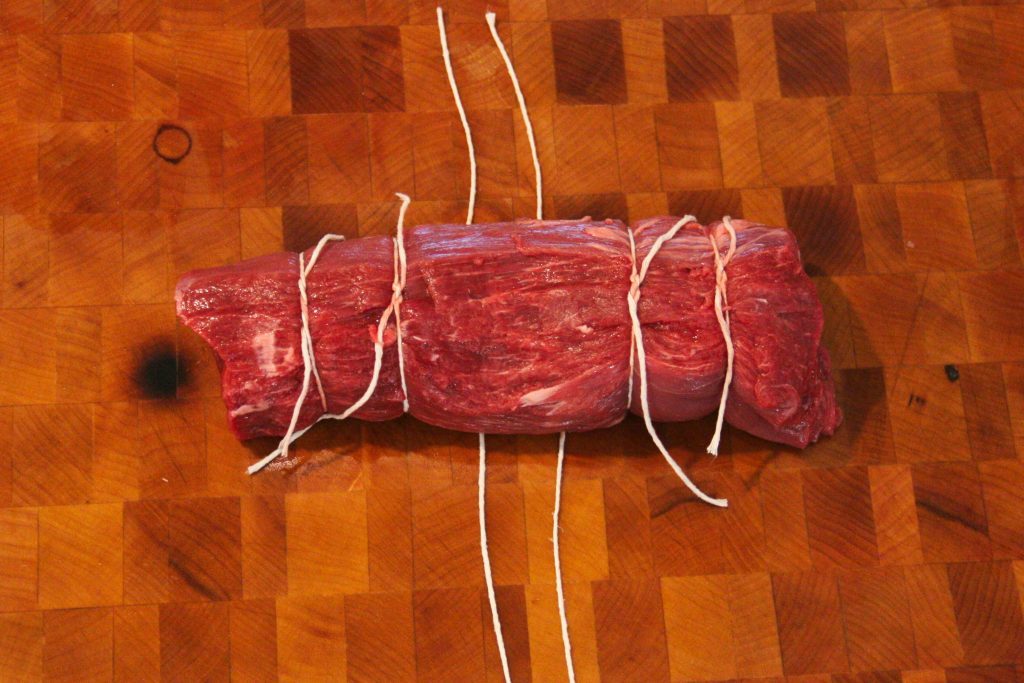
We start with our center cut filet. We need to make the meat a more uniform shape and help it stay that way during cooking. Use butchers’ twine and starting from the edges in, tie the beef in evenly spaced intervals. Liberally season with salt, pepper, and granulated garlic.
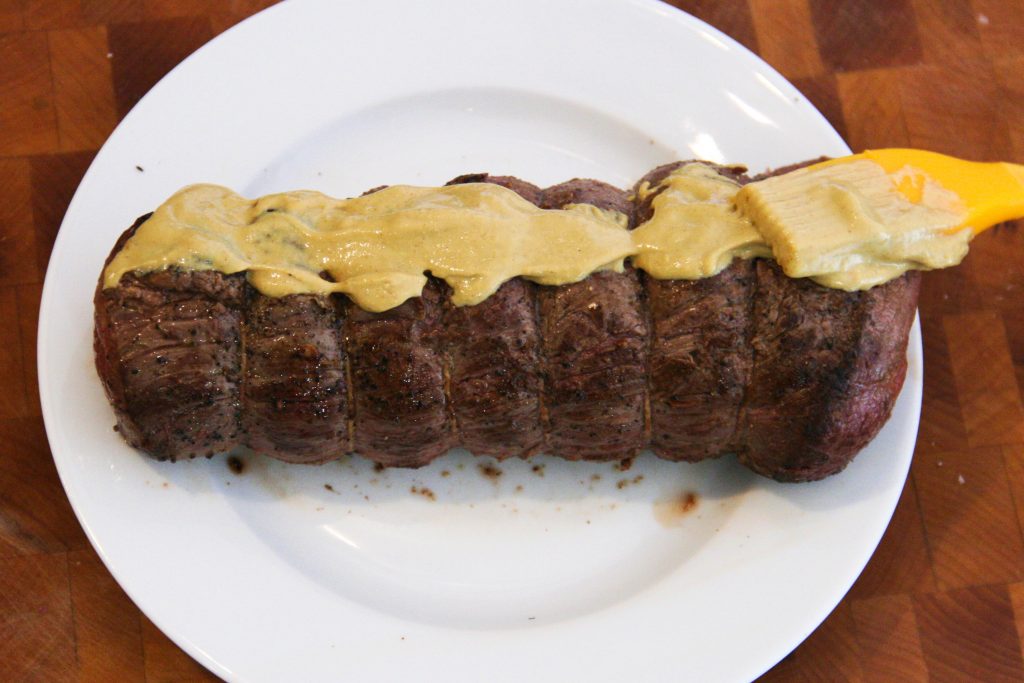
Add some oil to a heavy skillet and heat over high heat till just starting to shimmer. Add the beef and sear on all sides till evenly and darkly browned. Remove to a plate and let sit till cool. When tenderloin is cool to the touch, remove the twine and evenly rub with Dijon mustard. Place this in your refrigerator to chill completely.
DUXELLES PROCEDURE
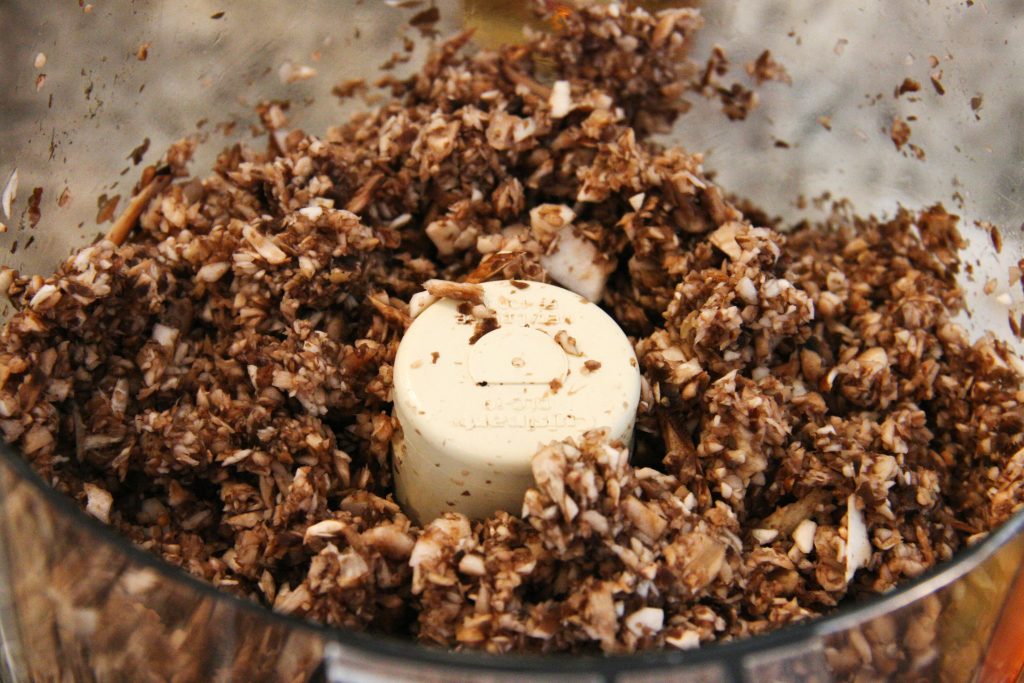
While the tenderloin is chilling its time to make mushroom duxelles. Clean your mushrooms of any dirt or debris then pulse them in the food processor till they are finely chopped but not a paste. Scrape the sides of the bowl after a few pulses to help keep the mixture uniform. Add butter to the same pan you seared the beef and bring to a medium heat.
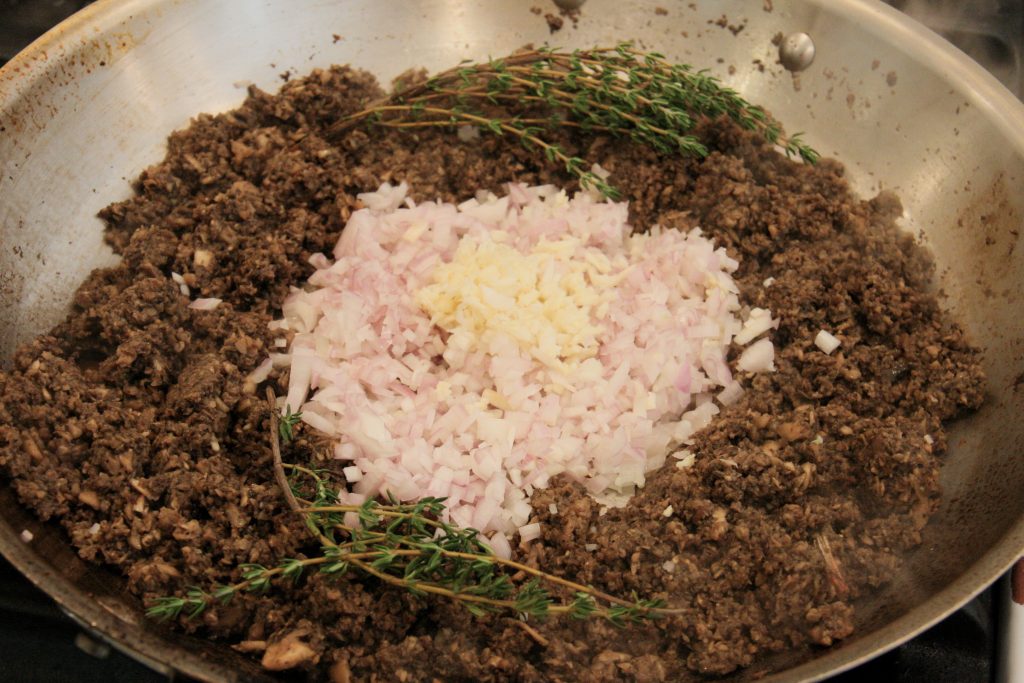
Add mushrooms and cook till most of their moisture is gone, scraping up any browned bits from the pan. Its important to do this part slowly. You want the mushrooms as dry as possible without burning them. Once they are dry add the remaining ingredients. We like to use whole thyme sprigs to perfume the mixture instead of overwhelming the mushrooms.
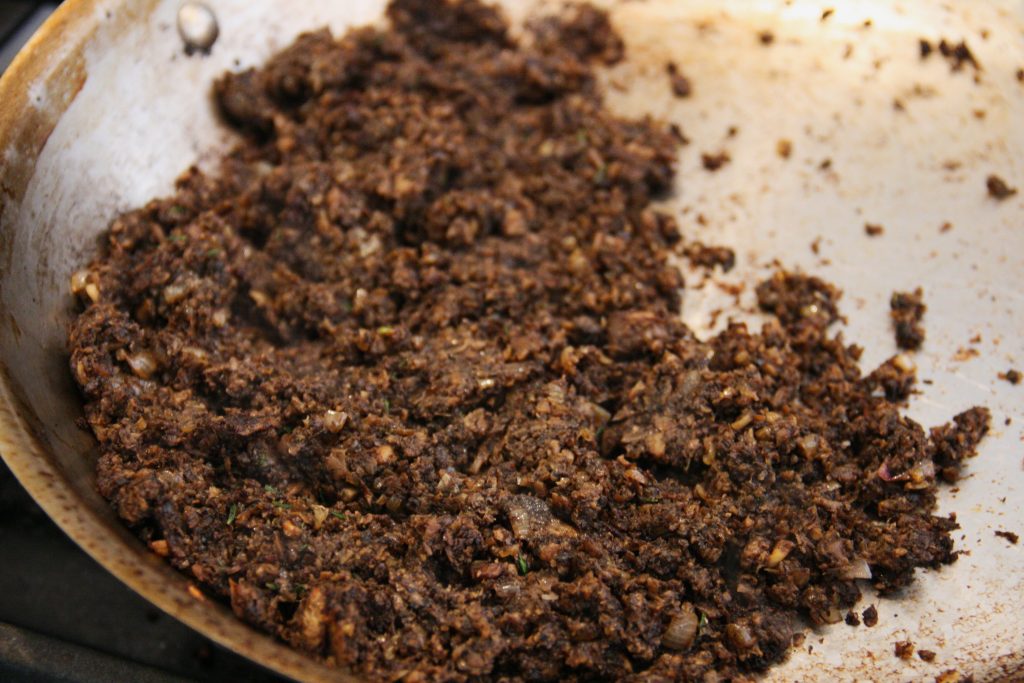
Let this cook, stirring often till the onions are soft then add the brandy and pan juices from the tenderloin. Add the brandy off the heat to reduce flare ups. Once the brandy is completely cooked out add the soy sauce and cook till the mushrooms are dry, dark brown and starting to stick to the bottom of the pan. Remove from heat, remove the thyme sprigs, and chill.
WRAPPING, WRAPPING, THEN BAKING
The wrapping is the most crucial step in the wellington process to help create a crisp pastry shell. We are taking out some extra insurance against moisture by incorporating phyllo dough into our internal wrapping.
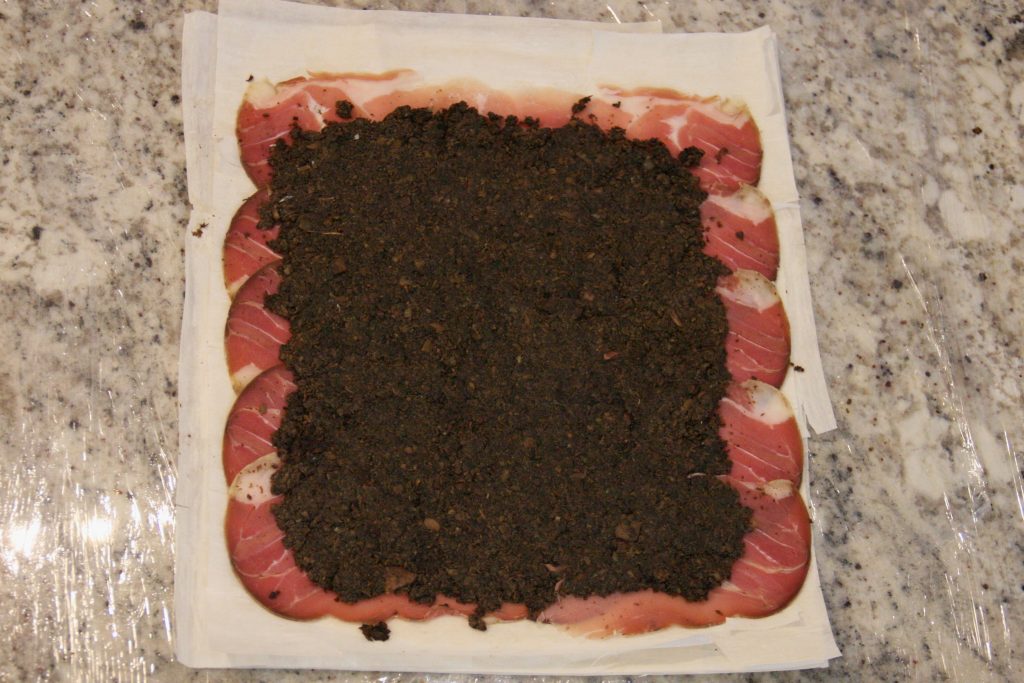
Lay out some plastic wrap, top with the phyllo sheets. Arrange prosciutto slices in an overlapping pattern, and finally top with your duxelles. Spread the duxelles evenly across the prosciutto making sure to press it down into a uniform layer. Any thin spots here create a weak point for moisture to make the pastry soggy. Place the tenderloin at the bottom and gently roll all the way up. Wrap tightly in your plastic wrap and twist the ends to tighten. Chill for 30 minutes.
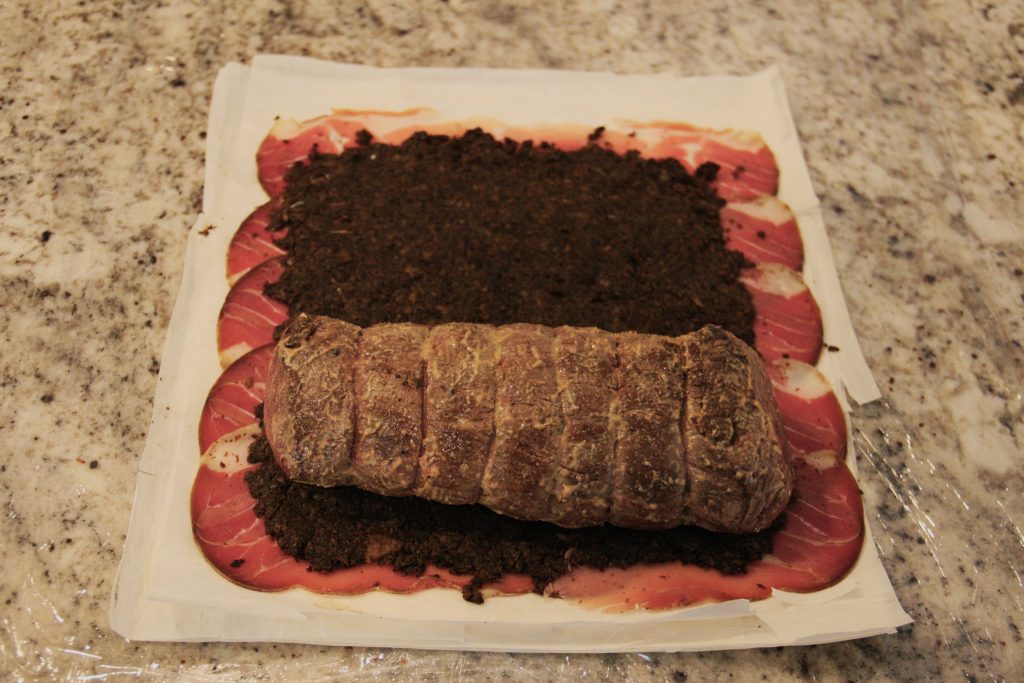
Roll out your puff pastry, remove the plastic from the beef and place it on the bottom end of the pastry. Roll over once and brush the pastry with a beaten egg then slice off the excess pastry. Fold the two ends of the of the pastry like a present then trim the bottom flap of excess pastry. Bring the side flaps up so they are just coming past the end of the meat. Move this to a plate in your refrigerator for 45 minutes to an hour.
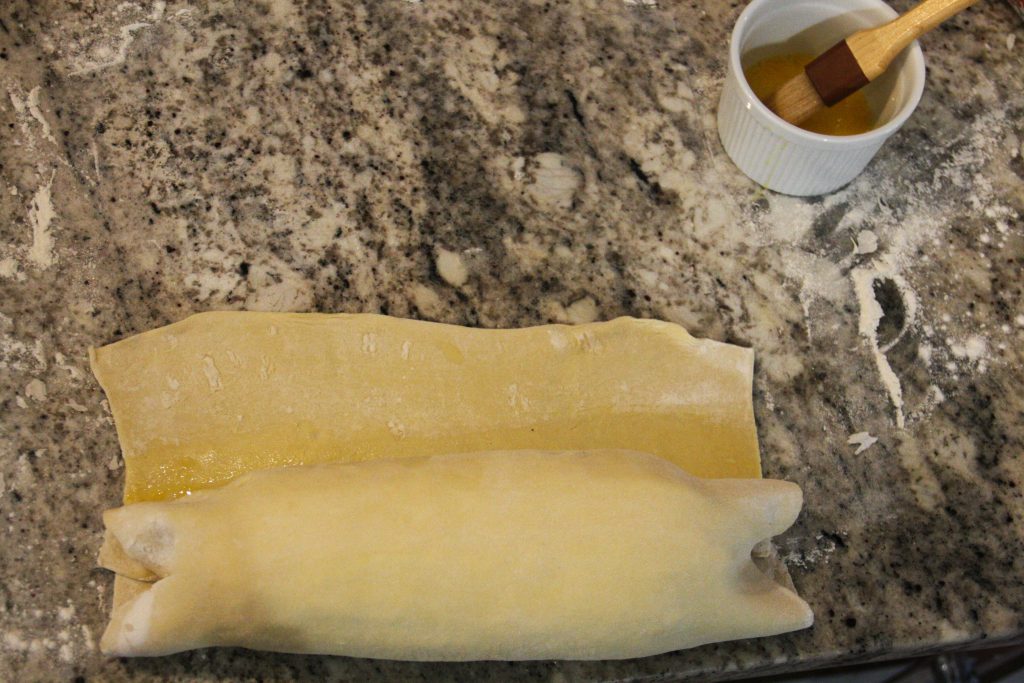
Preheat your oven to 425°F (218°C). If you have a pizza stone or a baking steel, make sure this is on your center rack. Let the stone heat for 20 minutes at temp.
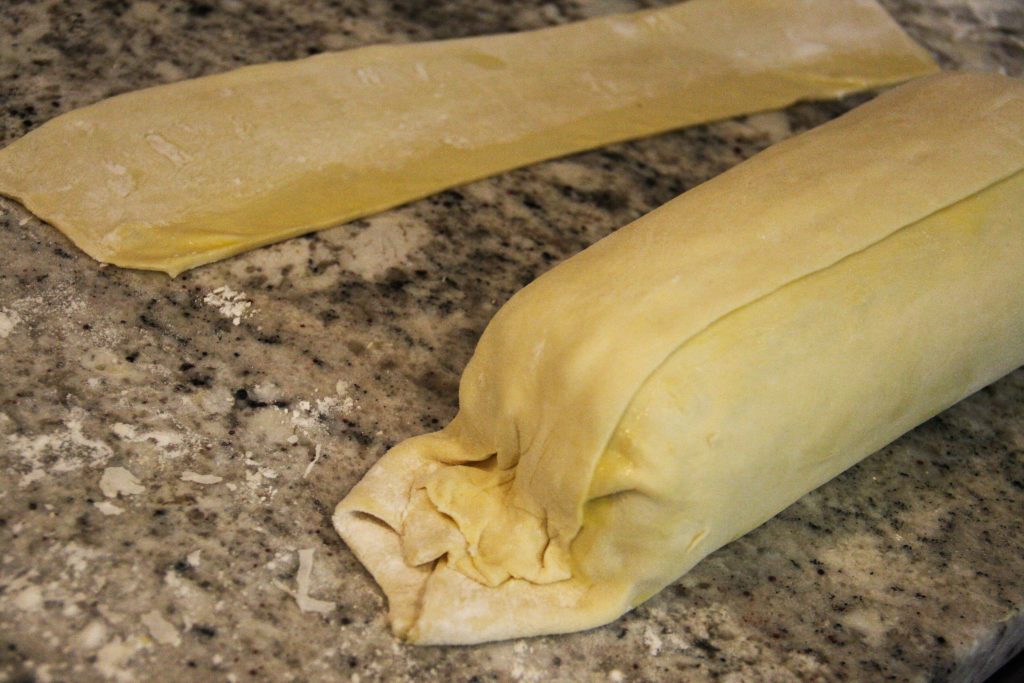
Transfer the beef to a foil lined tray and brush with beaten egg yolks. Using the back edge of a knife score the pastry, not all the way through, to make a decorative pattern. Sprinkle with salt and then insert your probe into the center of the meat through the end. Insert a probe from your ChefsTemp Quad XPro thermometer into the center of the meat. Place in the oven and bake until the pastry is golden brown and the temperature probe registers 110°F (43°C) for medium rare, approximately 40 minutes.
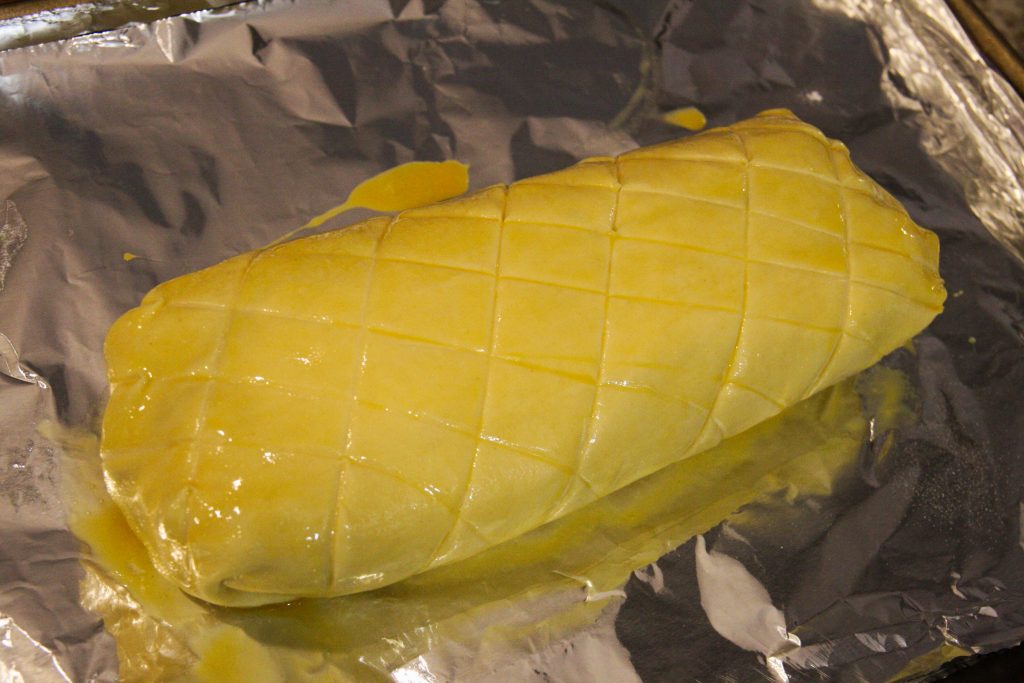
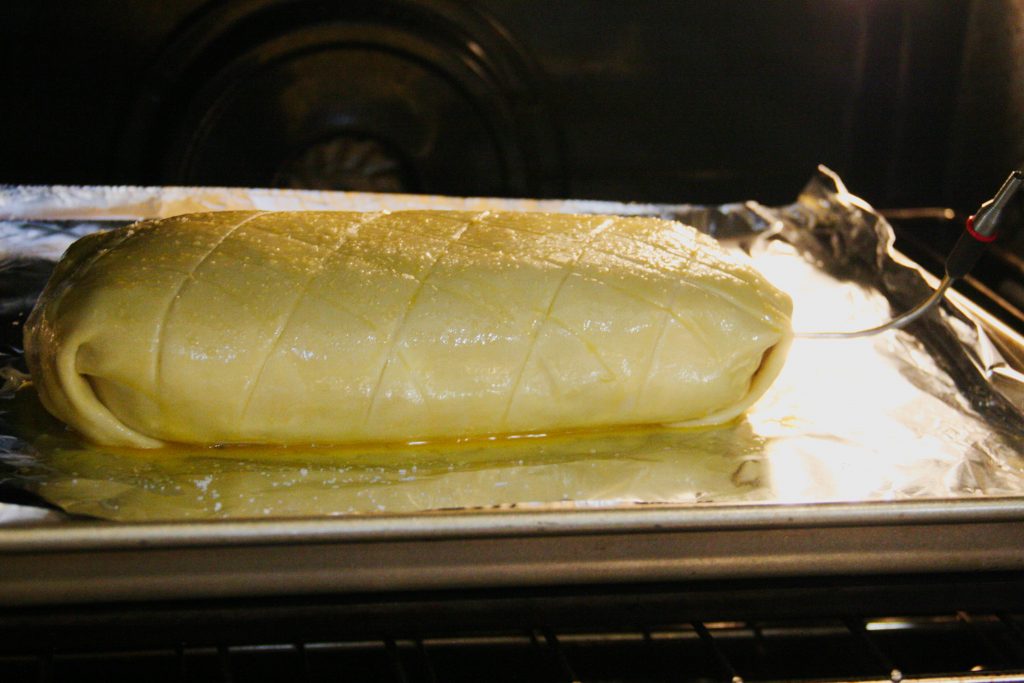
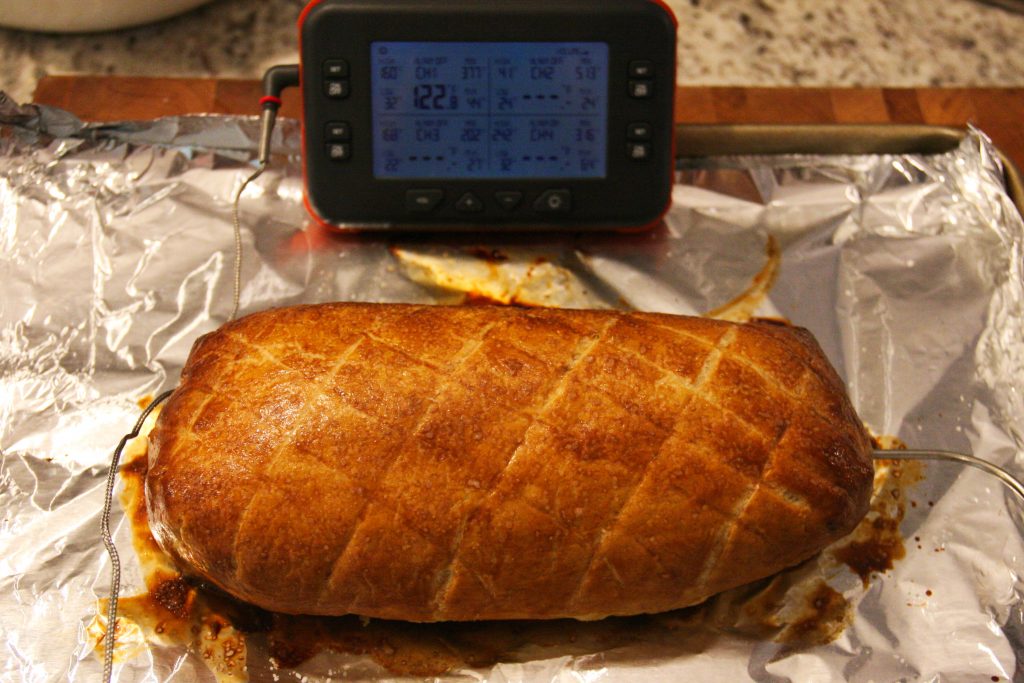
INGREDIENTS
- 1 Center cut tenderloin filet, cleaned, about 1.5-1.75 Pounds about 8 inches
- 1T Olive oil
- 2T Dijon Mustard
- Salt, Cracked black pepper, granulated garlic
- 24oz White and Cremini mushrooms
- 2 shallots
- 5 cloves garlic
- 2 sprigs fresh thyme
- ¼ C Brandy
- 5 tsp Soy sauce
- 3 T Butter
- 1T Olive oil
- Salt, Cracked Black Pepper
- 4 sheets phyllo Dough
- 12 Slices thinly sliced Prosciutto
- 1 Pkg Puff Pastry
- 2 eggs
INSTRUCTIONS
- Tie the tenderloin section using butchers’ twine in even intervals starting with the outside and moving your way inward. This will create a uniform shape for wrapping and roasting. Liberally season with kosher salt, pepper, and granulated garlic
- Heat vegetable oil in a skillet until nearly smoking. Add filet and sear on the first side till well browned, 1-2 minutes. Rotate and continue to sear until all sides are well browned.
- When tenderloin is cool to the touch, remove the twine and evenly rub with Dijon mustard. Place this in your refrigerator to chill completely.
The Mushroom Duxelles
- Remove any dirt or debris from the mushroom stems, discard any woody ends. Place them in a food processor and pulse, scrapping down the sides each time, till you have finely chopped mushrooms.
- In a skillet over medium heat add the butter, melt, then add the mushrooms. Cook until the mushrooms have released most of their liquid, stirring occasionally. Let these cook till brown and dry. Add the diced shallots, garlic, and thyme, continue to cook until the shallots are soft stirring frequently.
- Once the shallots are soft add the brandy and any juice that has released from the tenderloin, with the pan off the flame, and stir to pull up any browned bits stuck to the pan. Cook until brandy is nearly dissolved and add the soy sauce. Reduce heat and stir till the pan is looking dry. Remove from heat, remove the thyme sprig, and cool.
Assembly
- First lay out a double thick sheet of plastic wrap on your board. Make sure this is double the length of the filet extending 4 inches on each side.
- Start by placing phyllo dough on the plastic wrap. Then lay the prosciutto slices in a neat overlapping layer in a side-to-side pattern. Spread the duxelles evenly across the prosciutto making sure to press it down into a uniform layer.
- Lay the beef at the bottom of the phyllo sheet and tightly roll the tenderloin, using the plastic wrap as your guide, till you come to the end of the phyllo.
- Rewrap your beef in a new sheet of plastic wrap and twist the ends tight making a secure roll. Refrigerate at least 1 hour.
Wrapping and Baking
- Roll out puff pastry into a large rectangle several inches wider than the tenderloin on each side.
- Unwrap the tenderloin and place at the bottom edge of the pastry. Roll the tenderloin once over.
- Beat 1 egg and brush the pastry from edge to edge. Trim the excess and save the egg wash.
- Fold the edges of the of the pastry like a present then trim the bottom flap excess.
- Bring the side flaps up so they are just coming past the end of the meat. Move this to a plate in your refrigerator for at least 45 minutes to an hour.
- Preheat oven to 425°F (218°C). If you have a pizza stone or a baking steel, make sure this is on your center rack. Let the stone heat for 20 minutes at temp.
- Separate an egg and beat the egg yolk with the whole egg from earlier.
- Transfer beef to a foil lined tray and brush with beaten egg yolks. Using the back edge of a knife score the pastry, not all the way through, to make a decorative pattern. You can use additional puff pastry to make braided ropes or designs to be added on top as well.
- Sprinkle with salt and then insert a probe from your ChefsTemp Quad XProthermometer into the center of the meat.
- Place in the oven and bake until the pastry is golden brown and the temperature registers 110°F (43°C) for medium rare, approximately 40 minutes.
- Remove and let rest for 15-20 minutes before removing from the tray and slicing. Its always best to slice off one end first to get perfectly round slices for serving.
2 Comments
Comments are closed.
Discover Other ChefsTemp Products
Discover more recipes and learn kitchen tricks by joining our cooking family on Facebook.
You may also like:
















[…] internal temperature that meets the requirements. If you are looking for a recipe for mouthwatering beef wellington, we can help you with […]
[…] board and place the meat on top and in the middle of the twine. Following the same steps from our Beef Wellington recipe, start tying from the outside twine and work your way in to the center to create a tight […]